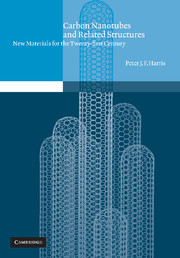Book contents
- Frontmatter
- Contents
- Acknowledgements
- 1 Introduction
- 2 Synthesis: Preparation methods, growth mechanisms and processing techniques
- 3 Structure
- 4 The physics of nanotubes
- 5 Nanocapsules and nanotest-tubes
- 6 The ultimate carbon fibre? The mechanical properties of carbon nanotubes
- 7 Curved crystals, inorganic fullerenes and nanorods
- 8 Carbon onions and spheroidal carbon
- 9 Future directions
- Name index
- Subject index
9 - Future directions
Published online by Cambridge University Press: 28 January 2010
- Frontmatter
- Contents
- Acknowledgements
- 1 Introduction
- 2 Synthesis: Preparation methods, growth mechanisms and processing techniques
- 3 Structure
- 4 The physics of nanotubes
- 5 Nanocapsules and nanotest-tubes
- 6 The ultimate carbon fibre? The mechanical properties of carbon nanotubes
- 7 Curved crystals, inorganic fullerenes and nanorods
- 8 Carbon onions and spheroidal carbon
- 9 Future directions
- Name index
- Subject index
Summary
What's past is prologue.
William Shakespeare, The TempestPhenomenal progress has been made in the science of carbon nanotubes since the publication of Iijima's landmark paper in 1991. We now know how to prepare nanotubes in bulk and how to purify them; how to prepare singlewalled as well as multiwalled tubes; how to produce layers of aligned tubes on substrates; and how to remove the end-caps and introduce foreign materials inside. Theoreticians have predicted that nanotubes should have extraordinary electronic properties, and many of these predictions have been confirmed experimentally. The mechanical properties of nanotubes have proved to be equally exceptional, and nanotube-containing composites are now exciting great interest. Nanotube research is burgeoning, with papers currently appearing at the rate of more than one per day. Nevertheless, it is quite conceivable that we have only scratched the surface of what may be possible in the new carbon science.
This final chapter considers some possible directions in which the subject might develop. Firstly, the development of a nanotube-based organic chemistry is discussed. Some tentative steps have already been taken in this direction, with the demonstration that nanotubes can be functionalised, and that functional groups can be removed, leaving the original nanotube structure intact. Secondly, some possible new, all-carbon, molecules with nanotube-based structures are described. This area is at present purely theoretical, since the techniques for synthesising these all-carbon structures have not yet been developed. Finally, the idea that nanotube-based structures might provide components for the nanomachines of the distant future is briefly discussed.
- Type
- Chapter
- Information
- Carbon Nanotubes and Related StructuresNew Materials for the Twenty-first Century, pp. 266 - 274Publisher: Cambridge University PressPrint publication year: 1999



